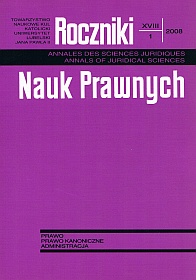The Creation of the Canon Form of Marriage Conclusion
Abstract
This article reflects on the process of creation of ordinary and extraordinary form of concluding canon marriage. The process comprised five stages, which brought about reforms carried out by the Catholic Church. The first stage was when the need for any form of conclusion of marriage was not even recognised, although a cleric was to be found to witness the event. The second stage is marked by the year 1563 in which the Trident Council enacted the Tametsi decree thereby introducing an obligatory form of concluding marriage. The decree, however, contained a great deal of inconsistencies so it was amended. In 1907 a new law was enacted, namely the Ne temere decree. The provisions of this decree were subsequently adopted by the Code of Canon Law of 1917, and later by the current Code of Canon Law of 1983, with amendments.
Copyright (c) 2008 Roczniki Nauk Prawnych

This work is licensed under a Creative Commons Attribution-NonCommercial-NoDerivatives 4.0 International License.


